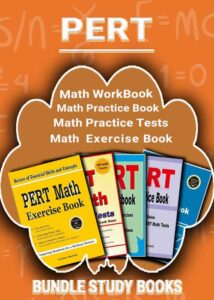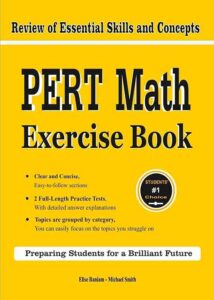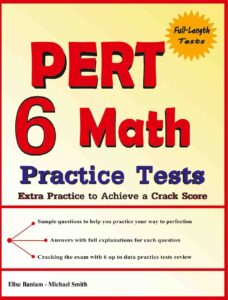
Study Time: 3minutes
How to Pass the PERT Math Test?
Florida colleges use the Postsecondary Education Readiness Test (PERT) to assess students’ readiness for college-level coursework. The math section of the PERT can be challenging, but with the proper preparation and strategies, you can pass it with flying colors. This guide provides practical tips and resources to help you succeed on the PERT Math test.
Understanding the PERT Math Test
The PERT Math test evaluates your skills in key mathematical areas to determine your readiness for college-level math courses. It covers various topics, including algebra, geometry, and statistics. Passing the PERT Math test can help you avoid remedial courses and start directly with credit-earning classes.
Test Structure
The PERT Math test is adaptive, meaning the difficulty of the questions adjusts based on your responses. It consists of 30 multiple-choice questions that cover the following areas:
- Arithmetic
- Elementary Algebra
- Intermediate Algebra
- Geometry
- Statistics
Scoring
Your score on the PERT Math test determines your placement in math courses. Higher scores can place you directly into college-level courses, while lower scores may require you to take remedial classes.
Key Topics to Study
Arithmetic
- Basic operations (addition, subtraction, multiplication, division)
- Fractions, decimals, and percentages
- Ratios and proportions
Elementary Algebra
- Simplifying expressions
- Solving linear equations and inequalities
- Factoring quadratic equations
Intermediate Algebra
- Systems of equations
- Functions and their properties
- Exponents and polynomials
- Rational expressions
Geometry
- Properties of shapes (triangles, quadrilaterals, circles)
- Perimeter, area, and volume calculations
- Pythagorean theorem
- Coordinate geometry
Statistics
- Mean, median, mode
- Probability
- Data interpretation
Preparation Strategies
Create a Study Plan
Develop a study schedule that covers all the key topics. Allocate specific times each day to focus on different areas. Consistent study habits are more effective than cramming.
Use Quality Study Resources
Invest in reputable study materials, such as PERT prep books and online courses. Some recommended resources include:
- “PERT Study Guide” by Trivium Test Prep
- “PERT Practice Questions” by Mometrix Test Preparation
- Khan Academy (for free online math tutorials)
Take Practice Tests
Practice tests are crucial for understanding the format and difficulty of the PERT Math test. They help you identify your strengths and weaknesses. Use official PERT practice tests and other reliable sources to simulate test conditions.
Focus on Weak Areas
Identify the areas where you need the most improvement and focus your study efforts there. Use targeted practice exercises to strengthen these weak spots.
Develop Test-Taking Strategies
Effective test-taking strategies can make a significant difference in your performance:
- Time Management: Pace yourself to ensure you have enough time to answer all questions. Don’t spend too much time on any one question.
- Process of Elimination: If you’re unsure of an answer, eliminate the incorrect options first to increase your chances of choosing the correct one.
- Educated Guessing: Make an educated guess if you’re unsure. Leaving a question unanswered guarantees no points, while a guess has the potential to earn points.
- Check Your Work: Review your answers to catch any mistakes if time permits.
Stay Relaxed and Confident
Test anxiety can negatively impact your performance—practice relaxation techniques such as deep breathing and positive visualization. Approach the test with confidence, knowing that you’ve prepared thoroughly.
Day of the Test
What to Bring
- A valid photo ID
- An approved calculator (if allowed by the testing center)
- PERT admission ticket (if required)
Test-Taking Tips
- Read Questions Carefully: Make sure you understand each question before answering.
- Use Scratch Paper: Write down calculations to help keep track of your work.
- Stay Calm: If you encounter a difficult question, stay calm and move on to the next one. You can always return to it later if you have time.
FAQs
What topics are covered on the PERT Math test?
The PERT Math test covers arithmetic, elementary algebra, intermediate algebra, geometry, and statistics.
How can I create an effective study plan for the PERT Math test?
Develop a study schedule that covers all key topics. Allocate specific daily times to focus on different areas and ensure consistent study habits.
Why are practice tests necessary for PERT Math preparation?
Practice tests help you understand the format and difficulty of the PERT Math test, identify your strengths and weaknesses, and improve your test-taking skills.
What are some effective test-taking strategies for the PERT Math test?
Effective strategies include time management, elimination, educated guessing, and reviewing your answers. Staying calm and confident is also crucial.
What should I bring on the day of the PERT Math test?
Bring a valid photo ID, an approved calculator (if allowed), and your PERT admission ticket (if required).
How can I stay relaxed and confident during the PERT Math test?
Practice relaxation techniques such as deep breathing and positive visualization. Approach the test with confidence, knowing that you’ve prepared thoroughly.
Passing the PERT Math test requires a solid understanding of key mathematical concepts, effective study strategies, and confident test-taking skills. Creating a structured study plan, using quality resources, and practicing regularly can improve your chances of success. Dedication and the right approach will prepare you to pass the PERT Math test and advance your educational goals.
Related posts:
No related posts.




